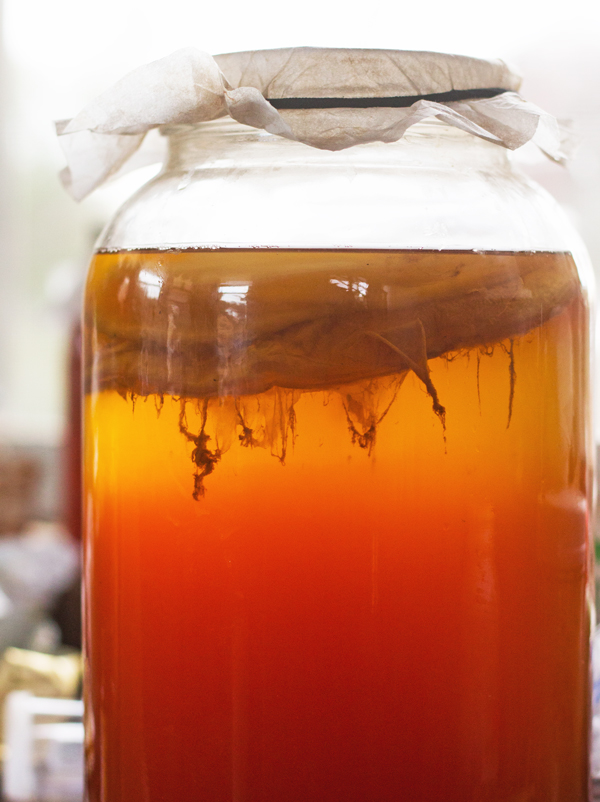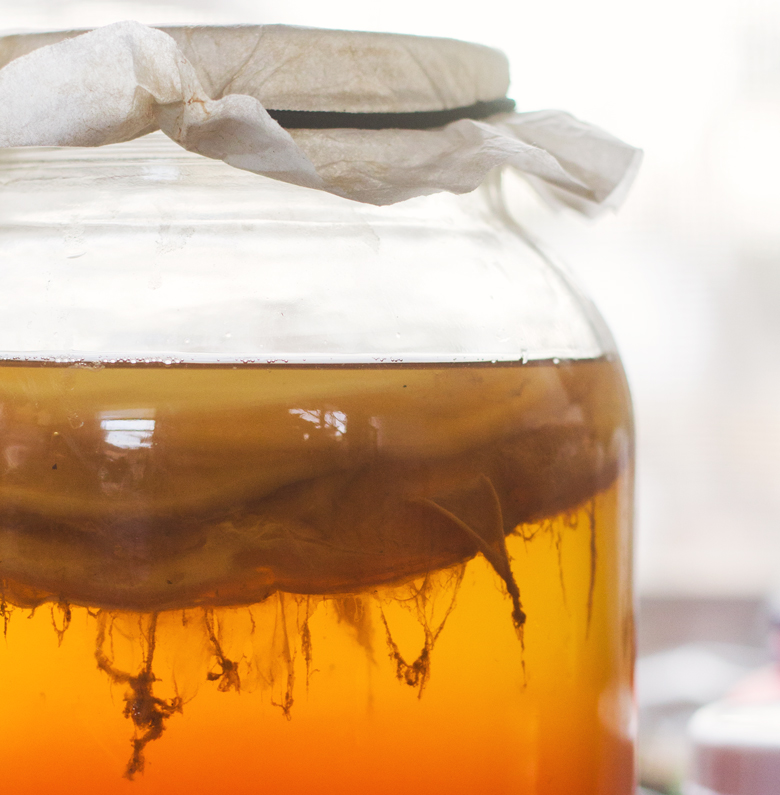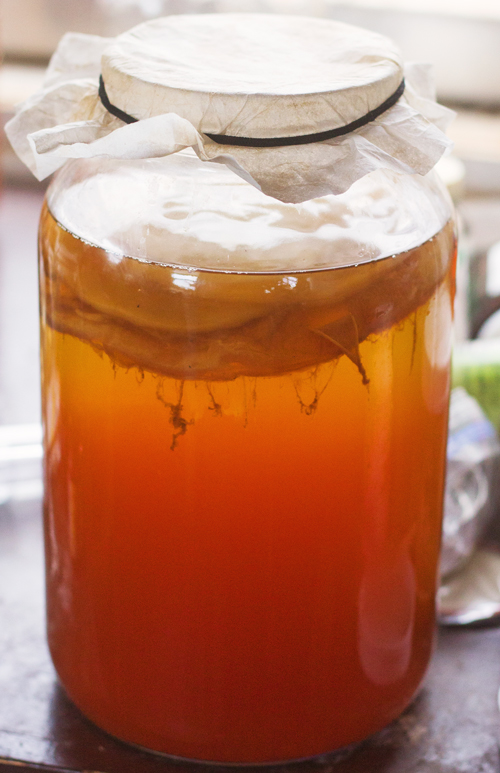Favorite Fermentation Equipment: Kombucha

Ever since I brought home that first bottle from Whole Foods, I’ve been a regular kombucha drinker. It took some convincing, but once Stewart came around it was in a big way and it is now easily his favorite beverage. He even takes over the brewing from time to time if I can’t get to it during a particularly busy season.
The children also love the stuff. Abram was the first baby to get some around the first year mark and ever since then all of the children start getting sips as soon as they can drink from a cup. Every one of them would drink as much kombucha as I would give them. I suppose all of that is to say that we can go through a lot of kombucha with six of us (plus one little sipper) drinking it on a daily basis.
Like most things around here, we have gone through many iterations of the kombucha brewing set up. Currently we have landed on six gallons brewing at a time, staggered so that approximately two are available for drinking at all times. That means I make the sweet tea about twice a week this time of year for a continuous supply. We also have a gallon of water kefir brewing which fills in any gaps as it is a faster culturing process.
Ingredients
For some reason I have always used organic tea bags rather than loose leaf. I brew loose leaf teas for sipping but have never used it for kombucha. As I write that I am starting to wonder why, besides the very small convenience factor. Do any of you use loose leaf?
Anyway, this brand of tea is the best value we have found for organic tea. I will brew using either black or oolong tea, depending on what we have. Oolong does produce a slightly lighter flavor and color but I really don’t see a big difference. Oolong may also brew a little faster than black tea but again the difference is very slight.
We also buy organic sugar in bulk from Azure for our kombucha brewing. It’s a lot less expensive and, so long as you can store it, it makes a lot of sense when you brew as much as we do.
Obviously you can’t brew kombucha without a SCOBY which I usually get from a neighbor or our friends at Cultures for Health. Be sure to get a cup of cultured kombucha for your next batch as that is imperative to proper fermentation.

Brewing Vessels
I think we’ve been brewing for about eight to nine years now and in that time we have used quart, half-gallon, gallon, and two-gallon containers for brewing. I’d be interested in trying one of those large kombucha brewing kegs but have never had access to one.
Right now we simply use gallon-sized glass jars with coffee filters attached with either a rubber band or a large hair tie. I reuse the coffee filters until they seem on the verge of completely breaking down and then get a new one.
It seems like this is a good place to share that I almost never wash out my brewing vessels. We simply pour off the ‘bucha until a cup or so of the brew remains with the SCOBY in the bottom of the jar. Then I fill it back up with cooled sweet tea, cover it, and put it back in the brewing station.
Air-Tight Bottles for Carbonation
More often than not we pour straight from the brewing vessel to the bevy of glasses held by little hands anxious for their buchee-water, as Ruthie calls it. If I want to start a new batch, want to create carbonation, or want to throw in some ginger or fruit for flavor, we bottle the kombucha for a second fermentation.
Over the years I have used store bought kombucha bottles either gifted to us or left from our own purchase. These work really well and are (sort of) free. Once I got a decent collection of flip-top bottles, however, I was sold. Just as finding a matching sock in this family is akin to striking gold, finding the caps that match the bottles can be hit or miss. Maybe if Mama was more organized…
Since I am often busy sock-hunting, I now mostly use a few of the flip-top bottles we’ve found at thrift stores, this brand and this brand of flip-top bottles we own, and the half-gallon kombucha jugs we have found at the health food store.

Funnels, Strainers, and Brushes
One thing I do not own that I am considering purchasing is a good bottle funnel. I often just wing it and pour directly into the flip-top bottles and usually that works… but sometimes it doesn’t. So I usually pour from the gallon to a two-cup measuring cup which I then use to fill the bottles.
If the yeast strands in kombucha weird you out, you can use a strainer as your pour from the brewing vessel. Keep in mind, however, that those yeast strands are both good at encouraging carbonation and are teeming with good microorganisms. At this point the yeast strands (and baby SCOBYs that often form) don’t bother us.
Finally, if you are using bottles, a bottle brush can be very helpful. Again, I like to embrace the bacteria and never sterilize any fermentation equipment for any type of fermentation projects. However, I do find that leaving bottles uncovered on the counter waiting for days on end to be washed tends to end in me trying to cram a dish rag into a bottle with a butter knife in desperation. Ahem. So I now use this bottle brush for those rather frequent times when I don’t get to all of the dishes for weeks days at a time.
Also in this series: Lacto-Fermented Vegetables.

I love reading how you do things. It is so my style as well. lol I wish I could drink kombacha on a regular basis; however, I struggle with anything yeasted or fermented. Keep up the good work and thank you for sharing your life. 🙂
Hi Shannon,
I’m new to kombucha. I love reading your posts and think that my husband will also enjoy. We will be brewing our first batch soon. Your information has helped with my confidence.
Thank you.
Just getting started with Kombucha and initially had a lot of questions. My instructor had us just put sugar in Kombucha tea and purified water with SCOBY and hang tea bags over the edge for 24 hours.
It worked! I used organic coconut sugar and it made water brown. I have yet to taste it and made 2nd fermentation with some pureed fruit. I have questions about how much fruit in the 2nd fermentation but from what I read sounds like that is negotiable. I also wonde rhow full to fill bottles. Do they need some air? I think what I did was OK and will find out in a couple of days. Thanks for your info , it was helpful!
Donna – Yes, always leave about an inch or so of head space to leave room for carbonation. Otherwise, you may end up with bottles that easily bubble over. 🙂
I have bought scoby from two different sources because my scoby makes kombucha but always looks like a green mold on top of the scoby. The first one looked black and green and gray which is why I bought a new one. I’ve followed all the directions but when I look at your pictures, the scoby looks tan in color with no discolorations at all. Confused but determined….any ideas?!